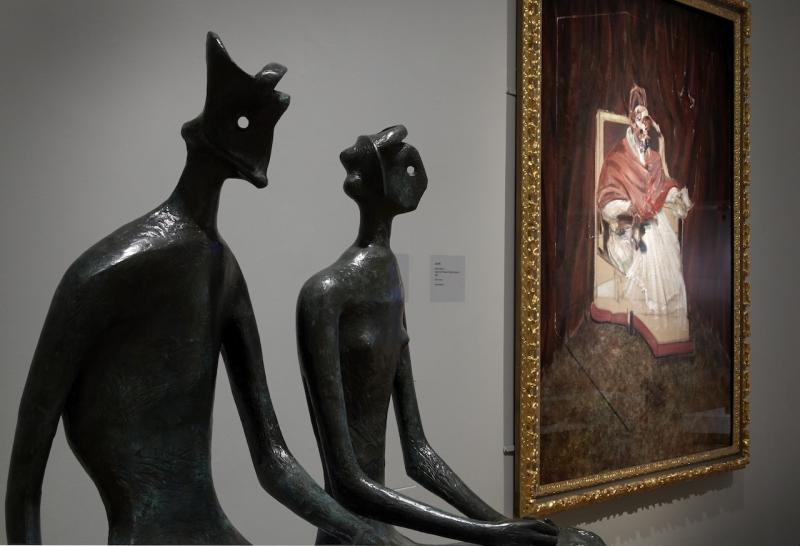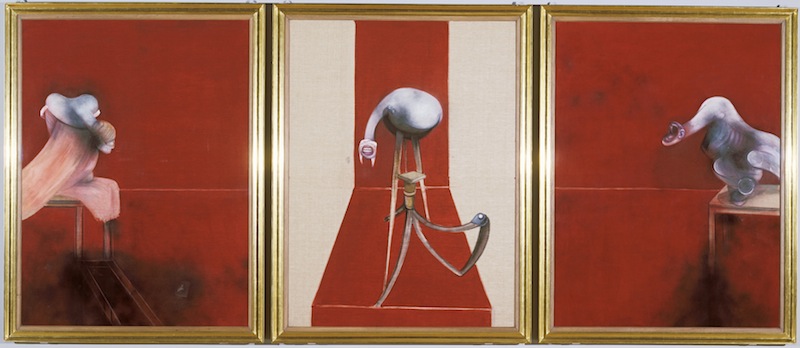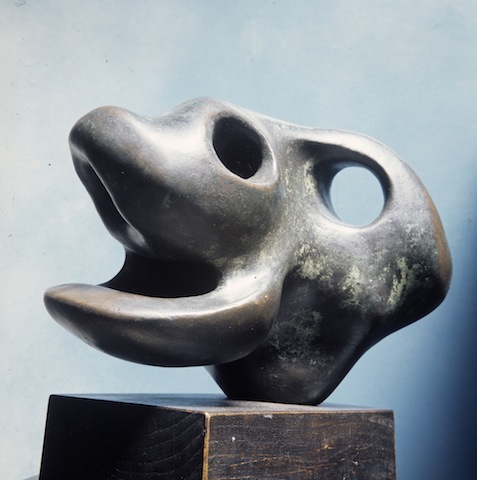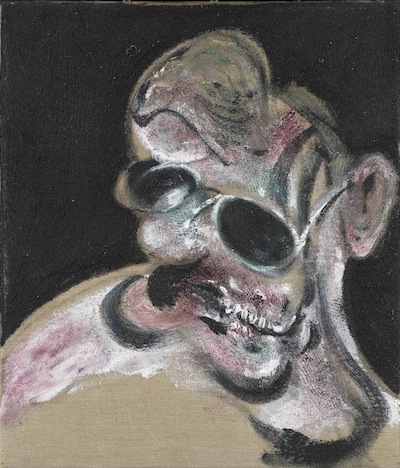Francis Bacon/Henry Moore: Flesh and Bone, Ashmolean Museum | reviews, news & interviews
Francis Bacon/Henry Moore: Flesh and Bone, Ashmolean Museum
Francis Bacon/Henry Moore: Flesh and Bone, Ashmolean Museum
What seems at first an unlikely pairing is anything but in this striking exhibition of two giants of British art

It is a shock, in this succinct exhibition of two British colossi of the past century, Henry Moore (1898-1986) and Francis Bacon (1909-1992), to be reminded of just how colossal and original are their achievements. We are shown their curiously affecting affinities, in their adherence to the human figure at the core of their work, and reminded through the display of documents and catalogues of their truly international success, both critical and financial.
The show is subtitled Flesh and Bone. Bacon is the purveyor of flesh in all kinds of livid and brilliant hues: greens, eerie pale rose pinks and shocking reds, sepulchral whites and dirty browns. Moore dissolves flesh into totemic bronze structures, conjures unlikely anatomies, fragments of bone or fossil, onto a gigantic scale. And his renderings in drawings and sculpture of monumental female form, are just that: monumental.
Seeing them together enhances them both by showing how cleverly and passionately they used their sources
We are introduced to the display by two huge photographs of their studios, and here the contrast and compare, the debate and argument of the show, is subtly clarified. Bacon’s huge heap of just plain mess: paint pots, brushes, postcards and reproductions on the wall, piles of paper scraps, which comprised the hundreds of visual sources he scrutinised and transformed, carpeting the floor. These indicate obsessions of course but also an ordered chaos. By some alchemy these mounds of rubbish were the source material for stupendously emotional, stridently coloured paintings, mostly large, always gold-framed and glazed so that, strikingly and even horribly direct as they are, they also keep a distance. Look at these wild creatures but only through the glass, darkly.
Moore’s studio at first glance seems an oasis of calm. But even here there are hundreds of small objects all waiting their turn as the source of the sculptures that almost always recall some animated form: life breathed into geological and biological fragments. Moore too could conjure monsters from these innocent scraps; on view here Composition, 1934 seems as though skeleton remains are about to march on the unsuspecting; Three Points, 1939-1940 suggest some sharp speared jaw about to consume an invisible nutrient wrested out of the air.
Both artists call on antiquity, admiring Egyptian art. Moore’s Shelter Drawing: Three Fates, 1941, are huge female creatures whose heads are nearly invisible. Bacon’s Second Version of Triptych 1944, painted in 1988, is a trio of monsters, menacing yet curiously wistful and oddly waif-like. They were both atheists, but religious imagery also affects their work. Moore drew crucifixions and mothers and children; Bacon not only did masterly transcriptions of Velazquez’s papal portraits, the pontiff screaming, his 1988 triptych reprises his earlier Three Figures at the Base of the Crucifixion (second version pictured below), while also recalling pagan fate or Furies.
 They share many of the same influences and looked at some of the same artists, as the inclusion in the exhibition of drawings by Michelangelo and drawings and sculpture by Rodin make clear. Picasso too was often called upon.
They share many of the same influences and looked at some of the same artists, as the inclusion in the exhibition of drawings by Michelangelo and drawings and sculpture by Rodin make clear. Picasso too was often called upon.
 The exhibition is more than the sum of its parts. It is all too easy to dismiss much of Moore, especially post-war when it seems there was almost a production line of huge bronzes, skeletons of unknown creatures blown up into giants, sometimes turning into a bland modernism-lite. Financial success and, in particular, success in North America, enabled assistants and the cost of casting. And sometimes Bacon too is dismissively characterised as just gruesome grand guignol (right: Henry Moore, Animal Head, 1951, © The Henry Moore Foundation).
The exhibition is more than the sum of its parts. It is all too easy to dismiss much of Moore, especially post-war when it seems there was almost a production line of huge bronzes, skeletons of unknown creatures blown up into giants, sometimes turning into a bland modernism-lite. Financial success and, in particular, success in North America, enabled assistants and the cost of casting. And sometimes Bacon too is dismissively characterised as just gruesome grand guignol (right: Henry Moore, Animal Head, 1951, © The Henry Moore Foundation).
But seeing them together enhances them both by showing us how cleverly and passionately they used their sources, to different but allied ends. We realise that both worked continually in an extraordinary area between figuration and abstraction: yes, everything is recognisable but also impossible, as layers of observed reality are twisted, distorted, transmogrified into something fantastical.
In Bacon, faces snarl, mouths grimace, teeth threaten, bodies writhe in impossible postures and monsters appear, yet there is always a strange vitality and order. He worked not only directly from observed human beings, but continually from photographs. He claimed to go where paint led, but made surprisingly careful preparations, drawing order from chaos (below: Francis Bacon, Portrait of Man with Glasses, 1963, © The Estate of Francis Bacon).
 For Moore, close observation of the natural world, from animals to landscape, with the stones, pebbles and detritus of beach and garden that he continually acquired and arranged, are conjured anew in the studio. A series of Moore’s drawings shows us surrealist objects, and those monumental stoical creatures who endured the London bombings, both groups set in shimmering vistas. Bacon caged his creatures, confining them to strangely airless interiors in the limbo land he created.
For Moore, close observation of the natural world, from animals to landscape, with the stones, pebbles and detritus of beach and garden that he continually acquired and arranged, are conjured anew in the studio. A series of Moore’s drawings shows us surrealist objects, and those monumental stoical creatures who endured the London bombings, both groups set in shimmering vistas. Bacon caged his creatures, confining them to strangely airless interiors in the limbo land he created.
The exhibition shows us our age of anxiety in visual terms. The comparisons which show us links between what seems at first an unlikely pairing – the tortured, magnificent, and grudgingly beautiful paintings by the urban Bacon, where all is in a state of flux, uncertain and on the point of dissolution, and the apparent solidity and serenity of much of Moore. In the light of Bacon, Moore’s solidity dissolves into a questioning of reality, an uneasy uncertainty. The art of Moore becomes darker and more erotic, more disturbing. Dark rainbows of vivid colour give Bacon’s figures a defiantly pessimistic lightheartedness. This genial horror is just what it is, get on with it; his art is a series of impertinent gestures to a terrible universe. Unmissable.
- Francis Bacon / Henry Moore: Flesh and Bone at Ashmolean Museum, Oxford, until 19 January 2014
Explore topics
Share this article
The future of Arts Journalism
You can stop theartsdesk.com closing!
We urgently need financing to survive. Our fundraising drive has thus far raised £49,000 but we need to reach £100,000 or we will be forced to close. Please contribute here: https://gofund.me/c3f6033d
And if you can forward this information to anyone who might assist, we’d be grateful.

Subscribe to theartsdesk.com
Thank you for continuing to read our work on theartsdesk.com. For unlimited access to every article in its entirety, including our archive of more than 15,000 pieces, we're asking for £5 per month or £40 per year. We feel it's a very good deal, and hope you do too.
To take a subscription now simply click here.
And if you're looking for that extra gift for a friend or family member, why not treat them to a theartsdesk.com gift subscription?
more Visual arts
 'We are bowled over!' Thank you for your messages of love and support
Much-appreciated words of commendation from readers and the cultural community
'We are bowled over!' Thank you for your messages of love and support
Much-appreciated words of commendation from readers and the cultural community
 Photo Oxford 2025 review - photography all over the town
At last, a UK festival that takes photography seriously
Photo Oxford 2025 review - photography all over the town
At last, a UK festival that takes photography seriously
![SEX MONEY RACE RELIGION [2016] by Gilbert and George. Installation shot of Gilbert & George 21ST CENTURY PICTURES Hayward Gallery](https://theartsdesk.com/sites/default/files/styles/thumbnail/public/mastimages/Gilbert%20%26%20George_%2021ST%20CENTURY%20PICTURES.%20SEX%20MONEY%20RACE%20RELIGION%20%5B2016%5D.%20Photo_%20Mark%20Blower.%20Courtesy%20of%20the%20Gilbert%20%26%20George%20and%20the%20Hayward%20Gallery._0.jpg?itok=7tVsLyR-) Gilbert & George, 21st Century Pictures, Hayward Gallery review - brash, bright and not so beautiful
The couple's coloured photomontages shout louder than ever, causing sensory overload
Gilbert & George, 21st Century Pictures, Hayward Gallery review - brash, bright and not so beautiful
The couple's coloured photomontages shout louder than ever, causing sensory overload
 Lee Miller, Tate Britain review - an extraordinary career that remains an enigma
Fashion photographer, artist or war reporter; will the real Lee Miller please step forward?
Lee Miller, Tate Britain review - an extraordinary career that remains an enigma
Fashion photographer, artist or war reporter; will the real Lee Miller please step forward?
 Kerry James Marshall: The Histories, Royal Academy review - a triumphant celebration of blackness
Room after room of glorious paintings
Kerry James Marshall: The Histories, Royal Academy review - a triumphant celebration of blackness
Room after room of glorious paintings
 Folkestone Triennial 2025 - landscape, seascape, art lovers' escape
Locally rooted festival brings home many but not all global concerns
Folkestone Triennial 2025 - landscape, seascape, art lovers' escape
Locally rooted festival brings home many but not all global concerns
 Sir Brian Clarke (1953-2025) - a personal tribute
Remembering an artist with a gift for the transcendent
Sir Brian Clarke (1953-2025) - a personal tribute
Remembering an artist with a gift for the transcendent
 Emily Kam Kngwarray, Tate Modern review - glimpses of another world
Pictures that are an affirmation of belonging
Emily Kam Kngwarray, Tate Modern review - glimpses of another world
Pictures that are an affirmation of belonging
 Kiefer / Van Gogh, Royal Academy review - a pairing of opposites
Small scale intensity meets large scale melodrama
Kiefer / Van Gogh, Royal Academy review - a pairing of opposites
Small scale intensity meets large scale melodrama
 Jenny Saville: The Anatomy of Painting, National Portrait Gallery review - a protégé losing her way
A brilliant painter in search of a worthwhile subject
Jenny Saville: The Anatomy of Painting, National Portrait Gallery review - a protégé losing her way
A brilliant painter in search of a worthwhile subject
 Abstract Erotic, Courtauld Gallery review - sculpture that is sensuous, funny and subversive
Testing the boundaries of good taste, and winning
Abstract Erotic, Courtauld Gallery review - sculpture that is sensuous, funny and subversive
Testing the boundaries of good taste, and winning
 Edward Burra, Tate Britain review - watercolour made mainstream
Social satire with a nasty bite
Edward Burra, Tate Britain review - watercolour made mainstream
Social satire with a nasty bite

Add comment